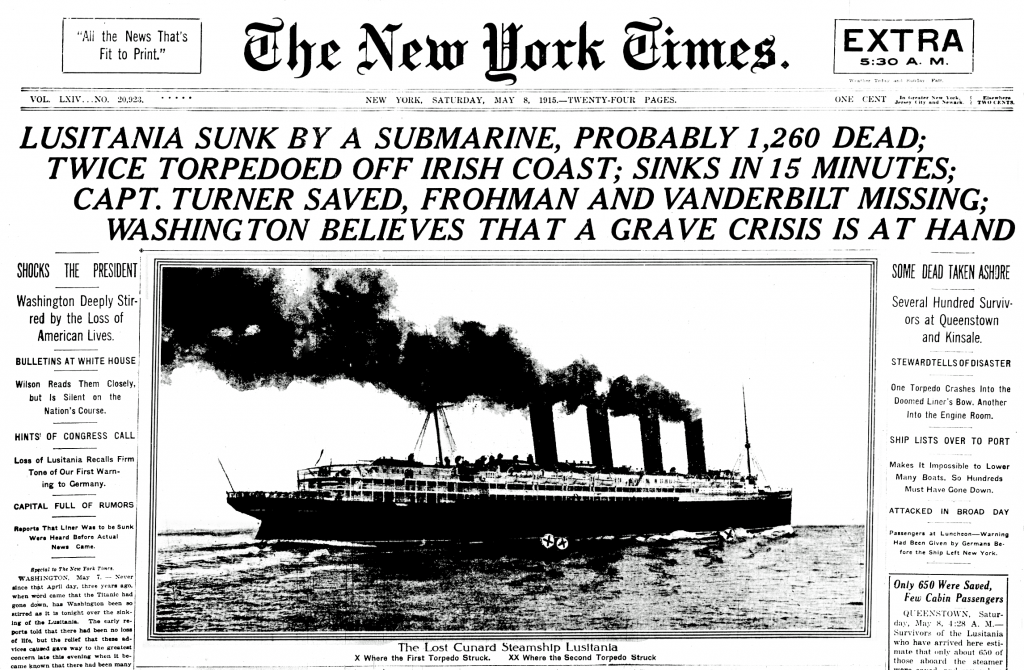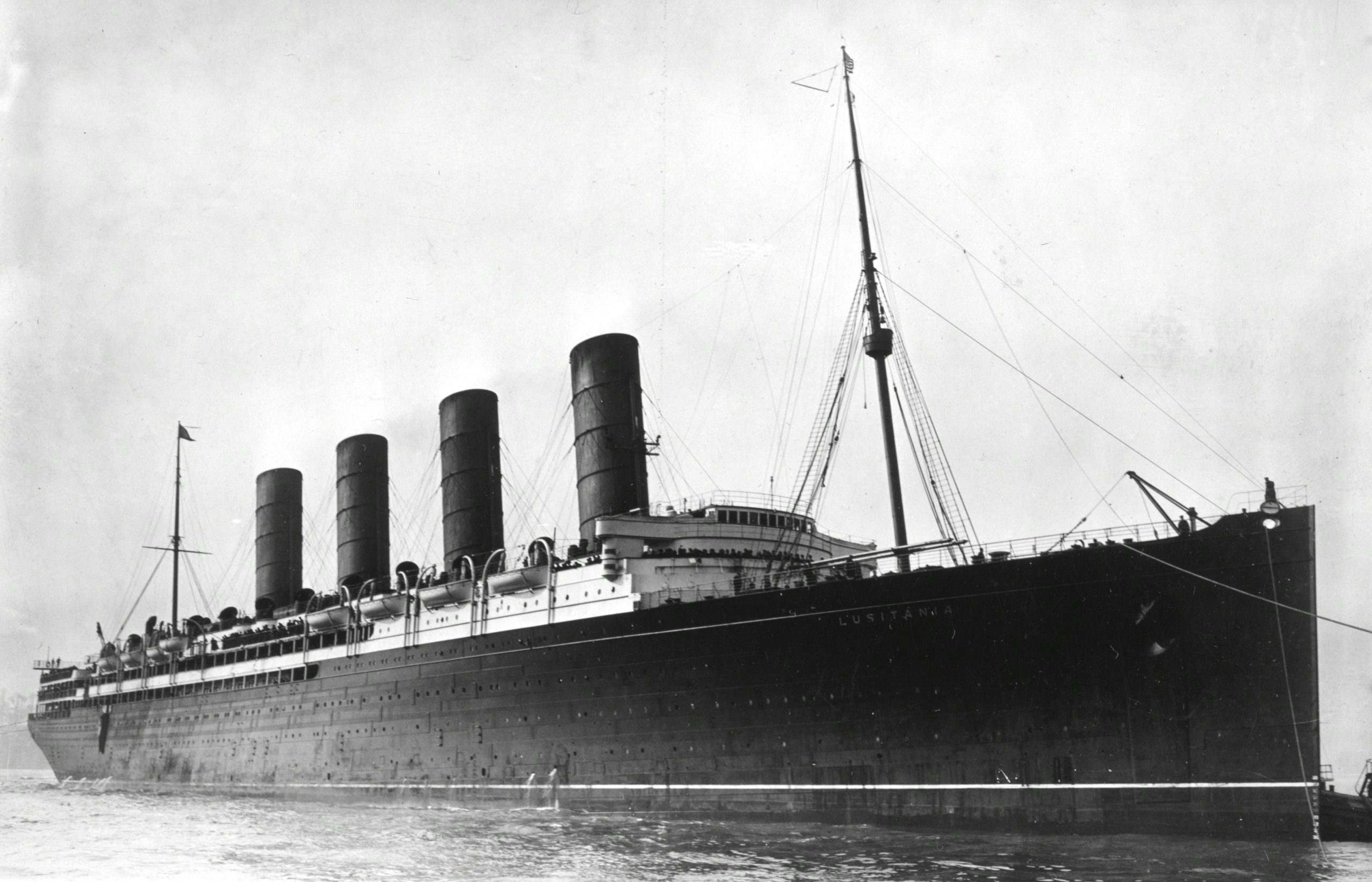 he sinking of the British Ocean liner “Lusitania,” torpedoed on May 7, 1915, off the coast of Ireland by the German submarine U-20, can be likened, as a maritime tragedy, to the end of the famous “Titanic,” which took place three years before, on April 14, 1912. On the “Lusitania,” at the time of the attack, in addition to crew members, 1,158 passengers (including 128 American passengers; according to other sources, 114 or even 200).
he sinking of the British Ocean liner “Lusitania,” torpedoed on May 7, 1915, off the coast of Ireland by the German submarine U-20, can be likened, as a maritime tragedy, to the end of the famous “Titanic,” which took place three years before, on April 14, 1912. On the “Lusitania,” at the time of the attack, in addition to crew members, 1,158 passengers (including 128 American passengers; according to other sources, 114 or even 200).
But in this case, it was not an iceberg that sent the liner to the bottom of the ocean, but the torpedo of a submarine. And Thomas Woodrow Wilson, the president of a neutral country not participating in World War I, the United States, did not forget this, and two years later, on April 2, 1917, he declared war on the Triple Alliance, pushing his country into conflagration on the side of the Entente.
An Impressive Ship
The Ocean liner “R.M.S. [Royal Mail Ship] Lusitania ”, built and armed for two years (1904–1906) by the famous shipping company Cunard Line, was first launched on June 7, 1906, at Clydebank, Scotland, after it had just left on the John Brown and Co. shipyard. Ltd., of Clydebank. It was the twin sister ship of two other famous ships, “Mauritania” and “Aquitaine”, with a length of 236 m, a tonnage of 31,550 tons, and could reach a maximum speed of 25 knots. Her crew consisted of no less than 802 people.

On September 7, 1907, “Lusitania” left the port of Liverpool for its maiden voyage. It was equipped with state-of-the-art technology. The British Admiralty had not skimped on the funds invested in building the ship and had thus achieved a much-desired result. When no one doubted that the Germans and their allies were preparing an armed confrontation, “Lusitania” was taken to the “Canada” dock in Liverpool on May 12, 1913, to have its hull strengthened and to be installed onboard. casemates capable of receiving 12 rapid-fire cannons. They will be installed onboard in August 1914.
In August 1914, just at the beginning of the First World War, the three ships, the “Lusitania,” the “Aquitaine” and the “Mauritania,” were requisitioned by the Royal Navy of Great Britain and transformed into auxiliary cruisers for war purposes. In other words, three warships. The “Aquitaine” and “Mauritania” will remain at this stage, never functioning as cruise ships. The same will not happen to “Lusitania”: it will be allowed to continue operating as an Ocean liner. It will continue to make a trip only once a month with a maximum speed reduced to 21 knots, transatlantic crossings for the Cunard line.
An unsuspected attack

On April 24, 1915, “Lusitania” arrived in New York, where it remained on a one-week stopover. On May 1, 1915, it began its journey to Liverpool. The Captain of the ship was the experienced William “Bowler Bill” Turner, 58, on the 102nd transatlantic crossing. The ship should have been escorted and protected by the British cruiser “Juno”, but by order of Admiral Fisher and the First Lord of the Admiralty, none other than Winston Churchill, the escort ship had been withdrawn two days ago.
On his way to Liverpool on May 7, 1915, at 2:25 p.m., R.M.S. Lusitania was hit by a torpedo near Fastnet, about 12 nautical miles off the coast of Ireland, off the southern tip of Ireland (Old Head of Kinsale), by the German U-20 submarine, commanded by Captain Walther Schwieger. The torpedo reached the starboard side of the ship, which was sailing at a speed of 18 knots to the port of Queenstown (now Cobh), 40 km off the south coast of Ireland. This area had already been declared a “war zone” by the Germans, and the British authorities of the presence of a German submarine had informed Captain Turner.
A torpedo or an inside job?
According to the testimonies of the survivors, about a third of the passengers, the sound of the explosion on impact with the torpedo was immediately followed by a second explosion, louder and more violent, considered abnormal, especially since a second torpedo was not fired. At first, it was attributed to the explosion of a boiler, but this explanation was immediately rejected.

Moreover, a fast and state-of-the-art ship like the “Lusitania” sank much too quickly — in exactly a quarter of an hour, compared to the three hours the “Titanic” sank, a bizarre fact because the ship had watertight compartments, which, from The captain’s order had recently been closed, and a message had been received from the Royal Navy that a German submarine was patrolling the region. Although the lifeboats had also been prepared, in the 15 minutes the ship hit to sink, only 6 of the 22 boats could be launched.
From the notes of the commander of the German submarine, Captain Walther Schwieger, who exactly on the eve of May 6, had sunk no less than three British cargo ships in this area, it appears that the torpedo was fired at 14:10 from a distance of 460 meters (500 yards). In his logbook, the German officer noted that the impact with the torpedo was followed by “a loud bang”, followed by “a thick cloud of smoke and debris projected over the chimneys”. “A second explosion was heard immediately, much louder than the first.” “Boiler, coal or powder?” The German asked himself. After 15–18 minutes, it was all over. Three years after the Titanic, the ocean was swallowing a second victim of the same caliber.
The last survivors

In addition to its crew of 802 people, “Lusitania” could carry a capacity of 2,165 passengers, of which 563 were in first class, 464 were in second class, and 1,138 were in third class. On the day of its sinking, there were 1,158 passengers on board, of which 128, according to some sources, were American citizens, including the millionaire Alfred G. Vanderbilt. Most perished in the waters of the Atlantic Ocean. The last survivor, Audrey Lawson-Johnson, aboard the ship when she was only three months and two days old, died on January 11, 2011, at the age of 95.
Avid Writer with invaluable knowledge of Humanity!
Upcoming historian with over 30 million views online.
“You make your own life.”




